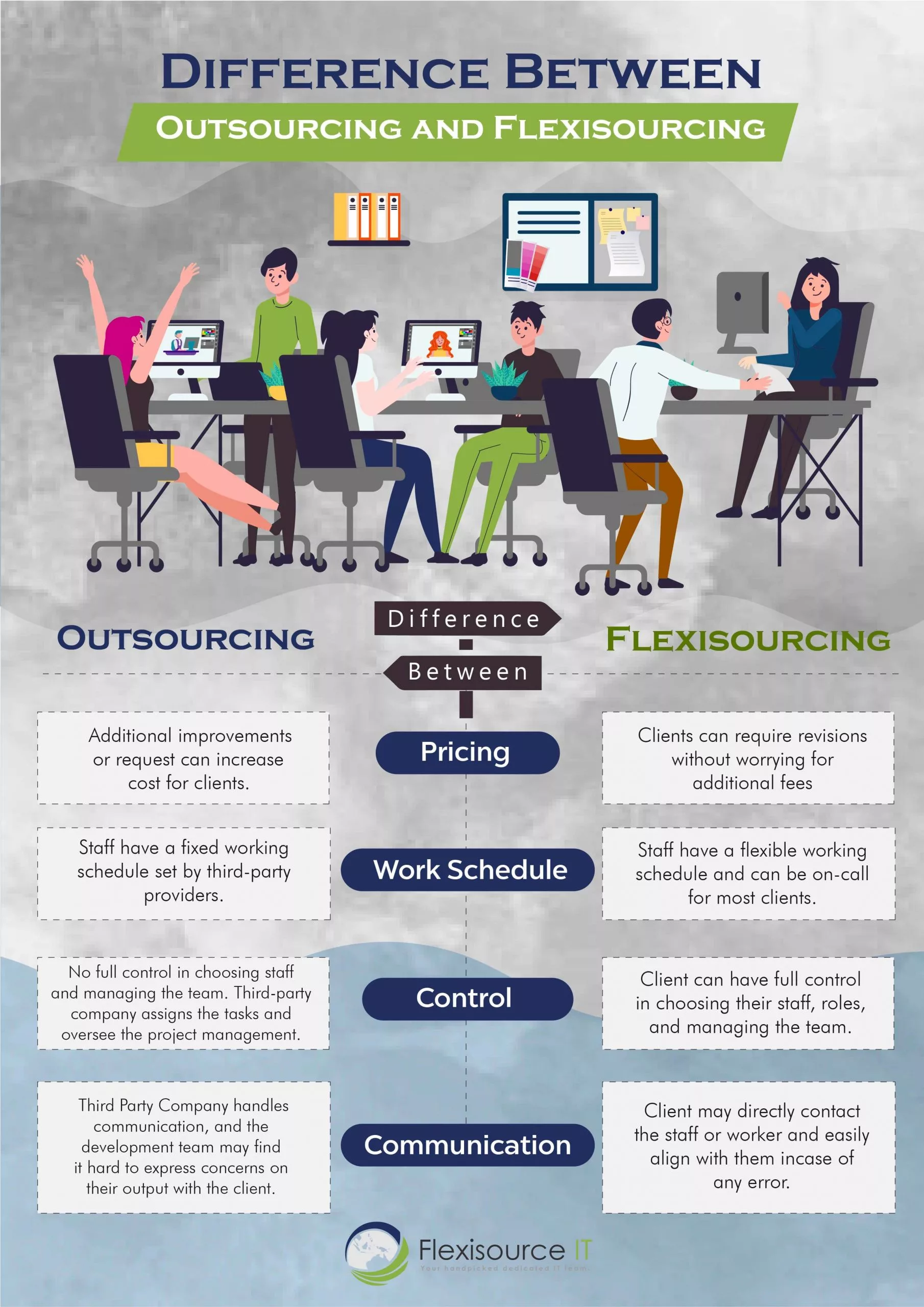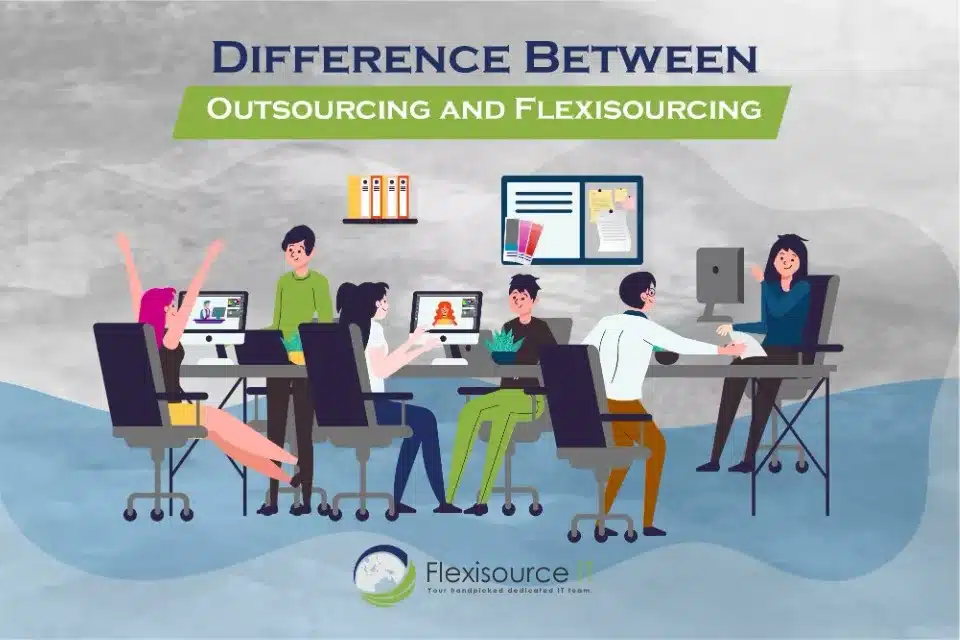Outsourcing is mainly the practice of obtaining skilled resources from third-party providers. It can be outsourcing your business functions to a company in the same country or the other side of the world. In the height of the COVID-19 pandemic, the number of business organizations adapting to this type of solution keeps increasing.
Simultaneously, the rise of Flexible Outsourcing or Flexisourcing is also taking effect during the pandemic. Flexisourcing, as its name suggests, is a flexible and dynamic solution that eliminates the constraints of traditional outsourcing models. It is a combination of project outsourcing and remote workers consultancy. With this, the business is only required to pay for the skills used and the services delivered.
What Is the Difference Between Flexisourcing and Outsourcing?

To further understand the key benefits of the two, we need to examine their differences. With this information, you will be able to analyse and identify which business strategy must take place. The following are the difference between Flexisourcing vs. Outsourcing:
- Outsourcing
It is widely known that Outsourcing is the most cost-effective alternative in acquiring top-performing skills for your business. Outsourcing service providers allow you to be accessible to the pool of talents and experts in the field. It also allows you to leverage the third-party providers’ workforce and resources in completing specific tasks. Usually, the client company is presented with a fixed price per project, depending on its complexity and urgency.
Related: Why is outsourcing good for startups?
Traditional outsourcing normally uses the Waterfall Methodology whereas it emphasizes a linear progression from beginning to end of a project. The relationship between the service provider and the client usually ends after the client provides the vendor the requirements and gives the vendor throws back with a “complete” project.
- Flexisourcing
Flexisoucing is the process of temporarily recruiting independent talents or acquiring talents from a third-party provider for a short-term contract. One significant characteristic of Flexisourcing is that skills are not exclusively committed to a particular client. They are allowed to take on other contractual projects from other clients. Payment is delivered depending on the mutual agreement. It can be a flat rate, per hour basis, or project basis.
Flexisouring uses Agile Method in managing projects. Unlike traditional outsourcing, Flexisourcing uses a more diversified outsourcing model that offers more advantages to the business owners or clients. They can have complete control over picking their staff and controlling them.
What are the Key Differences of Flexisourcing and Outsourcing?
Pricing
- In Outsourcing, costs can soar if additional improvements or requests are needed. Usually, Outsourcing uses the Fixed Price (FP) Model, whereas the third-party service provider sets a standard rate for the services, tools, and workspace. Cost may be charged monthly or annually, depending on the client. The job description is also constant and cannot be altered throughout the contract period. Any additional tasks may cost an additional fee or hiring a new workforce to cover the project.
- In Flexisourcing, on the other hand, workers are not employed full-time. They are paid for the services rendered or for every project completed. A project is not considered complete if revisions and improvements are still necessary to achieve the desired output. Unlike Outsourcing, Flexisourcing allows clients to demand revisions without thinking of the additional fees.
Work Schedule
- Usually, when Outsourcing, there is a fixed working schedule set by third-party providers. Onshore or offshore outsourcing staff only work on their designated work schedules. Having different time zones may affect communication. Thus, it can be hard to reach remote employees when there is an emergency or urgent request.
- Contrary to traditional Outsourcing, Flexisourcing is more flexible in working schedules. They can be on-call for clients and are easily reached when the need arises. This flexibility allows workers to work at their desired time and working pace, as long as the terms and end goal of the project are met on agreed time.
Control
- In Outsourcing, clients may lose control of the project. There is no complete control in choosing their staff and even directly managing them. It is the third-party company that assigns tasks to specific talents and oversees project management upon completion.
- Flexisourcing gives access to a broader selection of skilled workers. You have complete control in choosing their staff, selecting their roles, and even directly managing them.
Communication
- In Outsourcing, one of the main issues is communication. The development team may find it hard to express their intention and vision on the final output clearly. Since there is a third party in between, it may be hard for them to contact the outsourced workers directly. Other communication constraints may also stand in the way. The client may not easily communicate pain points with the onshore or offshore team accurately.
- Whereas in Flexisourcing, the client company may directly contact the staff or worker. It will be easier for them to communicate the misalignment of their goal and final output. Flexisourcing enables communication with the client and project managers, unlike Outsourcing, whereas communication is only possible through third-party management. Coordination with the management and project team is more accessible, making issues or changes easily conveyed to each other. Managers can also identify, analyse, and suggest the suitable approaches that can best work with your campaign.
What are the benefits of Flexisourcing?
- Easy Revision
When creating a product, goals, and targets constantly update to meet the demand of the market. Change is a constant part of any product, and your service provider should be able to adapt and apply these unique changes of your business to the product to drive better results and return of investment. Since Agile uses sprints in managing tasks, changes can easily be integrated during intervals.
- Lower Cost
Unlike traditional outsourcing, Flexisourcing uses Agile that contains a small sprints time frame that enables you to integrate any changes easily. In Outsourcing, the service provider does not usually cater to changes on the project without additional costs. With Flexisourcing, your team will be able to operate in a way that effectively adapts to any changes to your business operations.
- Better Return of Investment
Having better ROI is also an advantage of Flexisourcing. With Flexisourcing, you can easily adapt a product to the ever-changing demands of the product, producing a product that fits the needs of the people.
Flexisourcing vs. Outsourcing: Which is the Best?
Whether it is Flexisourcing or Outsourcing, the best model that works for you depends on your business requirements. Business requirements are perpetually changing. In today’s fast-paced society, businesses are pushed beyond their limits to adapt to the change. Before jumping into any business decision, it is always wiser to be well informed.
Good to know: Difference between BPO companies and KPO companies
If your business needs are focused on more steady results with determined deadlines, then traditional outsourcing is a viable option for you. Traditional outsourcing is a better option for your services with limited to no additional changes like payroll, accounting, telemarketing, data recording, customer support, lead generations, and more.
On the other hand, if your needs are more focused on IT outsourcing and software development, Flexisourcing should be the best choice. Since Flexisourcing uses Agile Project Management Methodology, Flexisourcing gives you the freedom to integrate and adapt to changes.
Where did Flexisourcing Start?
Flexisource IT’s CEO & founder Richard Gross started the term ‘Flexisourcing’ after seeing the problem that halts the development of businesses in Australia, lack of onshore talents, and costly business operations
Richard Gross’ interview with TechShake: “In Flexisource, we want to understand your business, we want to understand your roadmap, we want to understand where you’re going, and we want to understand the financial background in order to speak to the owners to discuss what they truly want to achieve”
Richard Gross explored opportunities abroad and went to the next tech melting pot of Southeast Asia, the Philippines. Richard Gross gathered the most competent IT professionals, project managers, and marketing strategists to revolutionize traditional outsourcing practices. Thus, Flexisourcing was born.
Flexisource IT is the only dedicated staff augmentation company in the Philippines specializing in Agile methodology, particularly in Scrum and Kanban.
Still on the fence? Learn more about the whys of Flexisourcing.









